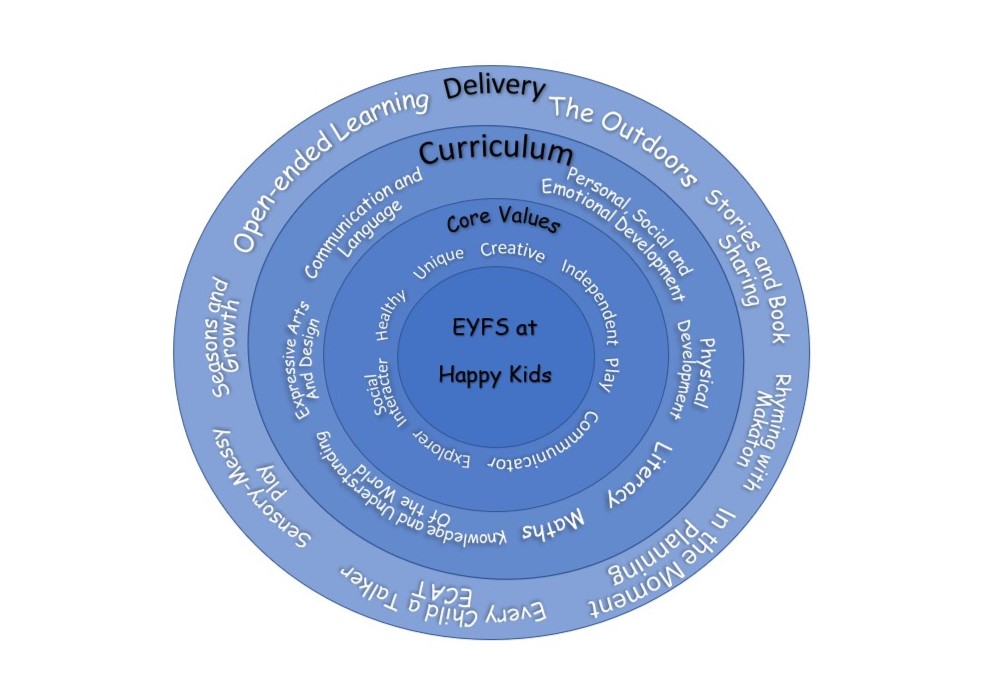Our Curriculum
Intent:
It is our aim that children become confident communicators, social interactors, and explorers during their time at Happy Kids. A child who is unique, creative, independent, a communicator, an explorer, a social interactor and healthy are well equipped for their next educational journey.
These characteristics are embedded within the ‘characteristic of effective learning’ within the Early Years Foundation Stage framework and are encouraged and promoted through play-based learning.
Implementation:
We recognise that the three prime areas of learning; Communication and Language, Personal, Social and Emotional Development and Physical Development within the EYFS are pivotal to supporting Literacy, Mathematics, Understanding of the World and Expressive Arts and Design. Practitioners are aware of this and focus on these areas when engaged in adult-led and child-led learning.
In addition to the continuous provisions in the setting, which evolves based on engagement, interest and how the resources/areas are used, practitioners also aim to facilitate and support learning and development through positive relationships, interactions, and role modelling.
Communication and Language: Children are supported and encouraged to extend their CL through positive interactions with skilled practitioners, who adapt their communication styles to meet the need/age of the child. This includes using strategies such as Makaton, match plus one, labelling, and repetition. Children are also exposed to music, rhyme, and stories 1:1 and in groups, initiated by both children and practitioners.
Personal, Social and Emotional Development: Practitioner’s support children to be sociable with their peers, to recognise and explore feelings, positive relationships, conflict resolution and to become independent.
Physical Development: Children are provided with an outdoor environment that allows for children to run, climb, build, explore and take risks in their play. Equally children are supported to develop their fine motor skills through resources and activities provided both inside and out. Practitioners talk to children about being safe, healthy, and looking after ourselves.

•The Outdoors
•Outdoor learning is just as important as the indoors environment. Children are provided with opportunities to run, climb, investigate, and explore their surroundings. Children have continuous acess to the outdoor environment.
•Stories and Book Sharing
•It is crucial for children to devleop a life-long love of reading and books. Children are read to and encouraged to story share every day as part of a group. All staff members are aware comprehension is just as vital as exposure to literature and encourage discussions to promote and develop this.
•Rhyming and Makaton
•All children participate in Rhyming and Makaton time whilst in the setting to support their CL and Literacy skills. Makaton is used in the setting for all children experiencing delays with their CL and PSED.
•In the Moment Planning
•In the moment planning and child-initiated play can be a fun and relaxed way for children to learn and progress in an Early Years setting. It is observed that both the children and the practitioners are more enthusiastic, more engaged, more relaxed, and forge better relationships.
•ECAT
•Every Child a Talker began as a national strategy in England, which focuses on supporting the communication skills of young children. Practitioners identify and support children who are displaying delays with their CL and support families to continue this support at home.
•Sensory – Messy Play
•Children use all of their senses to explore the environment around them. Sensory and messy play opportunities allow children to explore materials, shapes, colours etc whilst building up on their communication skills. Children have access to mud, sand, water and playdough every day.
•Seasons and Growth
•Children are supported and encouraged to become investigators in their natural environment. We explore the changes in the world around us during the seasons, we explore life cycles and how we change and grow over the school year.
•Open-ended Learning
•Children are provided with resources and an environment that is a balance between familiarity such as the role play area, but also resources and areas that provide and promote creativity, problem solving and collaborative working.